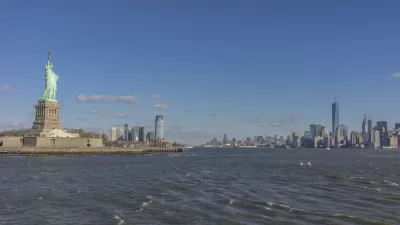New York City's population is expected to grow by one million residents by 2040. But where can housing be built to accommodate all these new residents? A new report from a Columbia University think tank identifies the most promising candidates.
Laura Kusisto looks at the findings of a new report [PDF] from Columbia University's Center for Urban Real Estate, which recommends the "most logical location for all this new housing: the city's waterfront neighborhoods, including Long Island City and Willets Point in Queens, Red Hook in Brooklyn and the Financial District..."
These recommendations, which "would pack more people into smaller areas than the Bloomberg administration has planned," raise some key questions about improvements that will need to be made to the city's existing infrastructure to accomodate such growth and address the city's growing inequity.
"Whether residents want more apartments in their neighborhoods remains to be seen," notes Kusisto. "In places such as Williamsburg where Bloomberg administration rezonings brought new residents, the result has been subway cars so packed that commuters wait for several trains to pass, lengthy kindergarten wait lists and promised parks that have yet to be delivered. The city has also yet to master the art of making tightly packed blocks of new glass towers feel like neighborhoods, rather than sterile enclaves."
Furthermore, focusing development along the waterfront, "raises serious questions after superstorm Sandy, when residents in Lower Manhattan, Long Island City and Red Hook were out of their homes for weeks or months."
FULL STORY: City's Boom Spurs a Need for Housing

Planetizen Federal Action Tracker
A weekly monitor of how Trump’s orders and actions are impacting planners and planning in America.

Chicago’s Ghost Rails
Just beneath the surface of the modern city lie the remnants of its expansive early 20th-century streetcar system.

San Antonio and Austin are Fusing Into one Massive Megaregion
The region spanning the two central Texas cities is growing fast, posing challenges for local infrastructure and water supplies.

Since Zion's Shuttles Went Electric “The Smog is Gone”
Visitors to Zion National Park can enjoy the canyon via the nation’s first fully electric park shuttle system.

Trump Distributing DOT Safety Funds at 1/10 Rate of Biden
Funds for Safe Streets and other transportation safety and equity programs are being held up by administrative reviews and conflicts with the Trump administration’s priorities.

German Cities Subsidize Taxis for Women Amid Wave of Violence
Free or low-cost taxi rides can help women navigate cities more safely, but critics say the programs don't address the root causes of violence against women.
Urban Design for Planners 1: Software Tools
This six-course series explores essential urban design concepts using open source software and equips planners with the tools they need to participate fully in the urban design process.
Planning for Universal Design
Learn the tools for implementing Universal Design in planning regulations.
planning NEXT
Appalachian Highlands Housing Partners
Mpact (founded as Rail~Volution)
City of Camden Redevelopment Agency
City of Astoria
City of Portland
City of Laramie





























